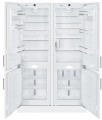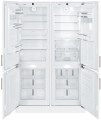Total capacity
The total volume of a refrigerator is the sum of the volumes of all its compartments, which can vary in specific capacity between different models. It's important to consider this when choosing a refrigerator.
A larger volume for a refrigerator can be beneficial for accommodating more food, but it can also increase the price and size of the appliance. This is especially important to consider if you plan to build the refrigerator into a specific space.
Refrigerator capacity
The refrigerating compartment is designed for storage of products that do not require freezing, i.e. cooling down to temperatures below zero. The temperature range inside varies from +2 to +10. In almost all modern refrigerators, it is this compartment that has the largest volume.
To ensure optimal performance and food quality, it's important to choose the appropriate volume for the refrigerating compartment based on your actual food storage needs and how often you replenish your supplies. Overfilling the compartment can have a negative impact on both the refrigerator's performance and the quality of the stored food.
For singles or couples, a refrigerating compartment of up to 200 liters is enough, while families or those who stock up on food should opt for models with up to 400 liters. Vertical refrigerators with separate freezer access are suitable for those who need moderate storage space, while side-by-side refrigerators with their typically larger volumes are a good option for those who require even more space and have ample free space.
Number of shelves
The amount of shelves in a refrigerator determines the division of space within the refrigeration compartment. Larger refrigeration compartments generally have more shelves, but there are also various configurations available even within the same volume (
3 shelves,
4 shelves,
5 shelves and more). It is worth considering that they are mostly removable, which allows you to adjust the height of the shelf. And if necessary, you can buy more.
Storage compartments
Apart from shelves, there are several additional compartments in a refrigerator, including a
a freshness zone,
a humidity zone,
a multi-zone and
a shelf for bottles.
— Freshness zone.It is a special compartment in a refrigerator designed for storing fresh products for an extended period. The temperature in this zone is slightly lower than the refrigerating chamber, typically around zero degrees, earning it the nickname "zero chamber". Such conditions help to preserve the freshness of products for up to 3-4 days. However, it's important to note that the temperature in the zero chamber may vary depending on the refrigerator model, ranging from 0 °C to +1...3 °C, which can impact the preservation of stored products.
— Humidity zone. Another specialized compartment, similar to the freshness zone, is designed to preserve the freshness of food items for an extended period. However, this compartment maintains high humidity at the same temperature as the rest of the refrigerator, which prevents the products from drying out. This feature is especially important for refrigerators with No Frost systems, which tend to blow moisture out of the refrigerator, leading to quicker drying of the contents.
— Multi-zone. This compartment in a refrigerator combines several functions of different compartments, such as the ability to w
...ork as a refrigerator or a freezer, along with other specific features like quickly cooling drinks, slow defrosting, and cooling hot dishes. Modern refrigerators offer more extensive capabilities with specific features, making the multi-zone compartment a valuable addition. Some models have the entire freezer performing the function of a multi-zone chamber, but most models have a separate compartment for it. The presence of a multi-zone compartment significantly expands the capabilities of a refrigerator.
— Shelf for bottles. It is a hanging accessory, typically in the form of a lattice, that is installed under a shelf in the refrigerator. It allows bottles to be stored horizontally, which saves space in the refrigerator while keeping them organized.Zero chamber capacity
The volume of the zero chamber provided in the refrigerator. Such a chamber is also referred to as a "freshness zone"; see "Functions" for more details.
Number of freezer drawers
The quantity of freezer drawers in a refrigerator affects the optimal organization of frozen foods. A larger number of drawers allows for better separation of different types of frozen products. However, in the majority of standard two-compartment refrigerators, there are typically
three freezer drawers.
Energy consumption per year
The average amount of energy consumed by a refrigerator in a year of operation.
The given parameter is an estimated value and assumes that the refrigerator operates under stable conditions without sudden temperature changes, frequent door openings, and within its designated climate class (see below). Actual energy consumption may deviate slightly from the stated value. Despite this, it is a useful parameter that allows for a rough comparison of different models in terms of energy efficiency.
It should be noted that the energy consumption per year is often a more practical and convenient parameter than the energy consumption class (see above), which is a relative indicator of how efficient a refrigerator is compared to other models of similar size and features. The energy consumption per year, on the other hand, provides an estimate of the actual electricity cost when using a particular refrigerator. For instance, a small two-door refrigerator with an energy class of A can consume less energy per year than a large side-by-side refrigerator with a class of A+++, despite the fact that the latter is formally more energy-efficient than the former in terms of its energy class.

